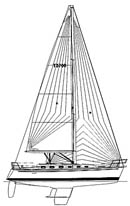Tartan 3700
Performance cruiserr
The hull is consistent with the other newer Tartans. The 3700 is beamy at 12 foot, 7 inches, for an L/B of 2.92. Any L/B less than 3 can be considered beamy.
In this model the beam is carried to the stern with minimal taper. This does several things, some good and some not so good, depending upon your perspective. A wide stern gives you more cockpit space and volume below for interior components like double quarter berths. Beam aft can also add form stability and sailing length.
On the down side, a wide stern increases wetted surface and makes a boat sticky in the light stuff. Heeled over, a wide, low-deadrise stern coupled with short aft overhang can give you a transom that drags and gurgles, sucking the bay along with you. It can also force the boat to roll bow down as it heels, which can give you a demanding helm. Most of these issues can be handled with prudent design, but it's tricky. I prefer a more moderate approach to beam aft. The D/L of this design is 210 (using the displacement listed for the beavertail keel model). The range of positive stability is listed as 125 degrees, and that's textbook normal for this type of boat.
Jackett loves to use angles in his interiors. If you take the angles out, it's a pretty standard layout. I think the angles may add some interest, and in some areas they can increase the apparent useful volume. Look at that huge double quarter berth. That's why the wide stern is so attractive to the designer.
The galley is nice, but once again we see sinks with no adjacent counter space. It's natural when preparing food to do it next to the sink. The engine box is under the companionway. I like the head and shower arrangement.
This rig is a very standard masthead, two-spreader sloop type with a slight sweep angle to the spreaders. There's not much to say about a rig like this. It's simple, strong, easy to set up and tune, and versatile. The mainsail overlaps the backstay by about 6 inches. The SA/D is 18.2. The deck plan features opening hatches in all living spaces and 12 opening ports in the cabintrunk. I know lining up opening ports like this does not look sexy, but you can never have too much ventilation. The sheerline is accented with a solid teak toerail. There is an anchor well on the foredeck. Note the location of the primary winches.
The Tartan 3700 appears to be a boat designed to appeal to a wide range of sailors.

Comments